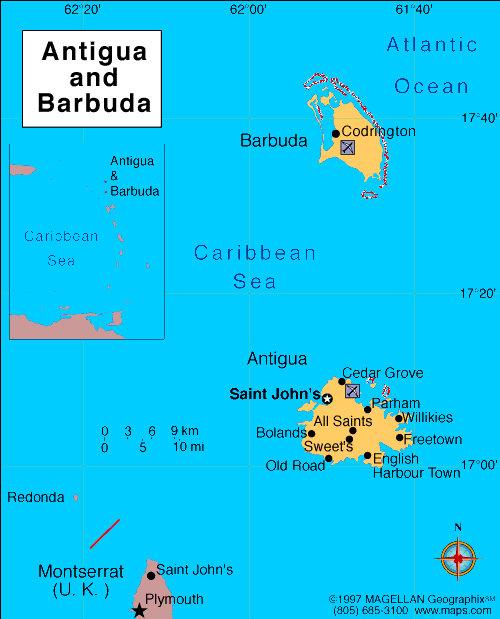Antigua and Barbuda

Antigua and Barbuda
Geography
Antigua, the larger of the two main islands, is 108 sq mi (280 sq km). The island dependencies of Redonda (an uninhabited rocky islet) and Barbuda (a coral island formerly known as Dulcina) are 0.5 sq mi (1.30 sq km) and 62 sq mi (161 sq km), respectively.
Government
Constitutional monarchy.
History
Antigua was explored by Christopher Columbus in 1493 and named for the Church of Santa Maria de la Antigua in Seville. Antigua was colonized by Britain in 1632; Barbuda was first colonized in 1678. The country joined the West Indies Federation in 1958. With the breakup of the federation, it became one of the West Indies Associated States in 1967, self-governing its internal affairs. Full independence was granted Nov. 1, 1981.
The Bird family has controlled the islands since Vere C. Bird founded the Antigua Labor Party in the mid-1940s. While tourism and financial services have turned the country into one of the more prosperous in the Caribbean, law enforcement officials have charged that Antigua and Barbuda is a major center of money laundering, drug trafficking, and arms smuggling. Several scandals tainted the Bird family, especially the 1995 conviction of Prime Minister Lester Bird's brother, Ivor, for cocaine smuggling. In 2000, Antigua and 35 other offshore banking centers agreed to reforms meant to prevent money laundering.
In March 2004, the Bird political dynasty came to an end when labor activist Baldwin Spencer defeated Lester Bird, who had been prime minister since 1994. In 2005, income tax, which had been eliminated in 1975, was reintroduced to help alleviate Antigua's deficit.


<< Home